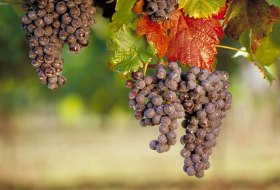Charlemagne, the German emperor, is said to have brought the Spätburgunder to Ingelheim by the Rhine. About 150 years ago, with the expansion of sparkling wine production, Spätburgunder made a boom, thanks to new plantations of pure Pinot vineyards. In Rheinhessen, covering an area of 1,474 hectares (just under 6% of the total vineyard), it ranks second among the red varieties.
This red classic requires a lot of care and places high demands on climate and soil.
Spätburgunder is traditionally made as a dry red wine. INternational style Spätburgunder is usuallymatured in new woodden barrels, showing intense aromas of re fruits and berries, accompanied by fine roasted aomas, hints of vanilla, mocha or chocolate. Spätburgunder Rosé makes a happy summer wine. If the healthy grapes are pressed immediately after harvesting, the bright juice produces a "Blanc de Noir", a white wine made from dark grapes. Pinot Noir is setting the bar for everyone wanting to be a top dog in high quality red wines. Pinot Noir is quite tricky. Wine journalist Jancis Robinson calls it "the most unruly of grape varieties. Even though it is male by grammar, it is feminine in nature and, with its caprices, it is driving winemakers and winelovers alike to dispair. Good Spätburgunder is far away from anything that can be described with simple fruit. Its extraordinary bouquet suggests many things - from violets to game, from rotten vegetables to truffles. "
Spätburgunder red wines are ideal food companions. They match dark meat, game and game birds, but also a variety of cheeses.



